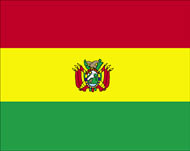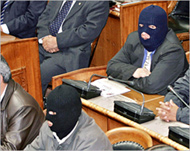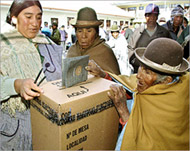Country profile: Bolivia
With a history of nearly 200 coups and counter-coups since its independence from Spain in 1825, Bolivia has been left a legacy of deep-seated poverty, social unrest and corruption along with an underground illegal drug economy.

Bolivia is landlocked between Peru, Paraguay, Argentina, Brazil and Chile in central South America. The west of Bolivia is situated in the Andes mountain range and the majority of the population live in the centre of the country on a highland plateau.
Even before the days of the Inca civilisation, the region now occupied by Bolivia was home to the great Tihuanaco Empire.
Silver mines were discovered by the Spanish as early as 1532 and thus the exploitation of Bolivia and its people began, a situation that has existed up until the present day.
Before 1825, Bolivia was attached to the vice-royalty of Peru and gained independence after 16 years of struggle under revolutionary leaders Simon Bolivar and Antonio Jose de Sucre.
Bolivia is the world’s third largest grower of coca leaves, following Colombia and Peru.
Unlike other South American countries, whose drug production has been steadily diminishing, Bolivia’s production has risen 23% since 2002.
 |
|
The Bolivian flag |
Despite its petroleum industry and the recent discovery of large deposits of natural gas, Bolivia remains one of the poorest countries in South America and the majority of the population still survive at a subsistence level.
Citizens of European or mixed European descent assert political and economic domination even though more then half the population is indigenous.
A very small minority of indigenous people have remained isolated from the European influence.
History and breathtaking scenery abound in Bolivia. It is home to the ruins of the Tiahuanaco civilisation at beautiful Lake Titicaca; the legendary mines of Potos?; elaborate old Jesuit missions and traces of the Inca empire.
Although 95% of Bolivia’s population are classified as Roman Catholic, the lack of clergy in rural areas has lead to the emergence of a folk religion of Christianity mixed with indigenous beliefs.
Capital: La Paz (seat of government); (Sucre – legal and judicial capital)
Official name: Republic of Bolivia
Government type: Republic
Population: 8,857,870 (July 2005 estimate)
Languages: Spanish (official), Quechua (official), Aymara (official)
Ethnic diversity: Quechua 30%, mestizo (mixed white and Amerindian ancestry) 30%, Aymara 25%, white 15%
Literacy rate: Age 15 and over can read and write
total population: 87.2%; male: 93.1%; female: 81.6% (2003 estimate)
Religion: Roman Catholic 95%, Protestant (Evangelical Methodist) 5%
 |
|
Members of the Movement |
Political parties and leaders: Bolivian Socialist Falange or FSB, Romel Pantoja; Civic Solidarity Union or UCS, Johnny Fernandez; Free Bolivia Movement or MBL, Franz Barrios; Marshal of Ayacucho Institutional Vanguard or VIMA, Freddy Zabala; Movement of the Revolutionary Left or MIR, Jaime Paz Zamora; Movement Toward Socialism or MAS, Evo Morales; Movement Without Fear or MSM, Juan Del Grando; Nationalist Democratic Action or ADN, Jorge Fernando Quiroga Ramirez; Nationalist Revolutionary Movement or MNR, leader NA; New Republican Force or NFR, Manfred Reyes-Villa; Pachakuti Indigenous Movement or MIP, Felipe Quispe; Socialist Party or PS, Jeres Justiniano.
Political pressure groups and leaders: Cocalero Groups; indigenous organisations; labor unions; Sole Confederation of Campesino Workers of Bolivia or CSUTCB, Roman Loayza.
International organisation participation includes: CAN, FAO, G-77, IADB, IAEA, IBRD, ICAO, ICCt, ICRM, IDA, IFAD, IFC, IFRCS, ILO, IMF, IMO, Interpol, IOC, IOM, ISO (correspondent), ITU, LAES, LAIA, Mercosur (associate), UN, UNAMSIL, UNCTAD, UNESCO, UNIDO, UNMIK, UNMIL, UNMISET, UNOCI, UPU, WCL, WCO, WFTU, WHO, WIPO, WMO, WToO, WTO.
 |
|
Congress debates the resignation |
Military branches: Army (Ejercito Boliviano), Navy (Fuerza Naval, includes Marines), Air Force (Fuerza Aerea Boliviana)
Military manpower – military age: 18 years of age for voluntary military service; when annual number of volunteers falls short of goal, compulsory recruitment is effected, including conscription of boys as young as 14; one estimate holds that 40% of the armed forces are under the age of 18, with 50% of those under the age of 16; conscript tour of duty – 12 months (2002).
Military manpower – there are approximately 1,923,234 (2005 estimate) males aged 18-49 are available for military service if the need arises.
Geography
Location: Central South America, southwest of Brazil.
Area: Total: 1,098,580sq km; land: 1,084,390sq km; water: 14,190sq km.
Land boundaries: Total: 6743km
border countries: Argentina 832km, Brazil 3400km, Chile 861km, Paraguay 750km, Peru 900km
Climate: Varies with altitude; humid and tropical to cold and semiarid.
 |
|
Voting on the nationalisation of |
Terrain: Rugged Andes mountains with a highland plateau (Altiplano), hills, lowland plains of the Amazon Basin
Natural resources: Tin, natural gas, petroleum, zinc, tungsten, antimony, silver, iron, lead, gold, timber, hydropower
Land use: Arable land: 2.67%; permanent crops: 0.19%; other: 97.14% (2001)
Natural hazards: Flooding in the northeast (March-April).
Environment – current issues: The clearing of land for agricultural purposes and the international demand for tropical timber are contributing to deforestation; soil erosion from overgrazing and poor cultivation methods (including slash-and-burn agriculture); desertification; loss of biodiversity; industrial pollution of water supplies used for drinking and irrigation.
Environment – international agreements: Party to: Biodiversity, Climate Change, Climate Change-Kyoto Protocol, Desertification, Endangered Species, Hazardous Wastes, Law of the Sea, Marine Dumping, Ozone Layer Protection, Ship Pollution, Tropical Timber 83, Tropical Timber 94, Wetlands
signed, but not ratified: Environmental Modification, Marine Life Conservation, Ozone Layer Protection
 |
|
Bolivian soldiers take control of |
Economy: Bolivia has large deposits of crude oil and natural gas but this has failed to end the crippling poverty that exists in Bolivia.
A significant proportion of the population makes its living from the growing of coca leaves and a government campaign to end this production has severely depressed the economy in the coca growing areas.
Bolivia remains heavily dependent on foreign assistance.
Current government goals include educational reform, attracting foreign investment and resolving disputes with the coca industry.
Gross Domestic Product: $2463.18 per person
GDP – real growth rate: 3.7% (2004 estimate)
Industries: Mining, smelting, petroleum, food and beverages, tobacco, handicrafts, clothing.
Exports: Natural gas, soybeans and soy products, crude petroleum, zinc ore, tin.
Imports: Petroleum products, plastics, paper, aircraft and aircraft parts, prepared foods, automobiles, insecticides, soya beans.
Labour force: 3.8 million (2004 estimate)
Unemployment rate: 9.2% in urban areas
note: widespread underemployment (2003 estimate)
Currency: Boliviano
Transnational Issues: Chile rebuffs Bolivia’s reactivated claim to restore the Atacama corridor, ceded to Chile in 1884, offering instead unrestricted but not sovereign maritime access through Chile for Bolivian natural gas and other commodities.
Sources:, CIA World fact book, Infoplease.com, Nationmaster.com, Wikipedia.org